Maximizing Small Spaces with Custom Closets
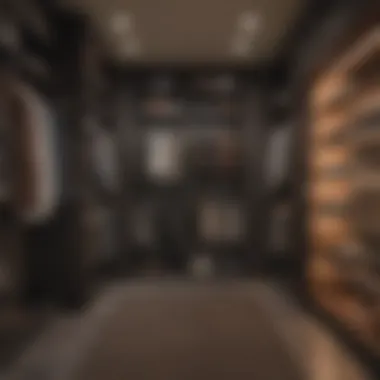

Intro
In a world where living spaces are shrinking but the need for storage keeps expanding, finding efficient ways to utilize small areas becomes paramount. Custom closets are not just a luxury; they are a necessity that can transform a cluttered room into an organized oasis. Tailored storage solutions provide both aesthetic charm and practical functionality, allowing homeowners to maximize every inch without feeling cramped. Let’s embark on a journey to explore how custom closets can be the key to unlocking the full potential of your space.
Design Inspiration
When diving into the realm of custom closets, the first consideration often lies in design inspiration. This is where creativity meets practicality.
Current Trends in Interior Design
The current trends in interior design lean heavily towards minimalism while embracing multifunctionality. Homeowners are focusing on clean lines, neutral palettes, and materials that reflect a more sustainable ethos. Innovative approaches, such as adjustable shelving and modular units, cater to diverse lifestyles and preferences. This contemporary design language helps in creating spaces that feel open and inviting, regardless of size.
By incorporating elements like mirrored surfaces or built-in lighting, closets can act not just as utilitarian furniture but as aesthetic focal points in your home. For instance, consider how a sliding door closet with a glass finish can visually expand a small room while providing ample storage. The trick lies in harmonizing these custom features with the overall theme of your home to ensure coherence.
Color Schemes and Palette Ideas
Choosing color schemes for custom closets requires careful thought. Soft, muted tones often work well in smaller spaces, making them feel more expansive. Shades like pale gray, soft beige, or muted pastels can create a soothing atmosphere and complement various decor styles.
Here are ideas to consider:
- Monochrome: Sticking to one color in various shades can create a seamless look.
- Accent Colors: Introduce bold colors through hardware or interior accents.
- Natural Tones: Earthy colors paired with wood finishes create a calming retreat.
The palette you choose needs to reflect not only your personal style but should also enhance the ambient light in the space. Dark colors may work in larger areas but can make a small space feel cramped if not paired effectively with adequate lighting.
"The right combination of color and light can reshape your perception of space."
Custom closets should not only offer storage solutions but also embody an aspect of your personality. Adding in unique hardware, like vintage knobs or custom handles, can allow your storage systems to tell a story while serving their primary function.
In the quest for maximizing small spaces, custom closets prove to be more than just functional; they’re versatile canvases for oosing style and ingenuity.
Understanding the Importance of Custom Closets
Creating order from chaos can feel like a Herculean task, especially when juggling limited space. That’s where custom closets come into play; they’re not just about storage, they're about turning constraints into opportunities. The importance of this topic cannot be overstated for homeowners and design enthusiasts, as efficient use of small spaces not only enhances functionality but also brings a sense of peace amidst the clutter.
The Concept of Customization in Closet Design
Customization in closet design refers to tailoring the solutions specifically to fit an individual’s needs and the unique dimensions of the space. It’s about more than slapping some shelves together and calling it a day. Think about it—every nook and cranny can be a treasure trove of storage potential. Custom closets offer flexibility in terms of layouts, finishes, and accessories. Consider how a L-shaped closet can make use of corner space that often gets ignored. Or the idea of incorporating pull-down shelving for the higher reaches where dust bunnies often rule instead of your favorite shoes.
This approach allows you to take every inch seriously. By applying thoughtful design that reflects personal aesthetics and practical requirements, you set up a functional environment that enhances your life. For instance, utilizing sliding doors can save space, while mirrors can create an illusion of airiness. The myriad of choices means that the final product reflects not just functionality but a blend of style and personality.
Benefits of Tailored Storage for Small Spaces
Tailoring storage to meet specific needs comes with a laundry list of benefits, particularly for smaller living spaces. To highlight a few key advantages:
- Maximized Space Usage: Custom closets convert dead space into functional areas. Think of that cramped hallway—how about making it a mini-library with built-in shelves?
- Clutter Reduction: Effective storage solutions decrease clutter, making your space feel more open and manageable. When everything has its place, finding things is a breeze.
- Enhanced Organization: Each individual can adapt their closet to reflect personal organizational styles, whether that’s by categorizing by season or by color. This personal touch cannot be replicated with pre-fabricated solutions.
- Increased Property Value: Custom closets can enhance the overall appeal of your home, thereby raising its market value. Homebuyers often look for storage options, so a well-thought-out closet can be a selling point.
Evaluating Space Constraints
When it comes to making the most of a smaller living space, understanding the limitations and potential of what you have is vital. Evaluating space constraints isn't just a simple act of measurement; it's about recognizing the true essence of your environment. Knowing what dimensions you’re working with allows you to tailor a closet solution that feels almost like it was made just for you. By delving into this section, you’ll see why assessing space goes beyond numbers to actually influence how your closet and thus your daily life, function.
Assessing Available Space Dimensions
Before you roll up your sleeves and start dreaming about what might fit into your closet, it’s wise to take stock of the available dimensions. Measure not only the width and height of the area but also the depth, and take note of any existing features that might affect design, such as windows or light fixtures.
- Start with a Tape Measure: It may sound basic, but nothing beats an old-school tape measure for gathering accurate dimensions. Write down the measurements clearly to avoid confusion.
- Consider Shape and Structure: Not all closets are rectangles. Look for walls that are angled or have irregular shapes. Understanding these details lets you think creatively about how to allocate space.
- Account for Accessibility: Your closet shouldn't just look good; it should be approachable. Ensure that wherever you place shelves or rods, they're easily reachable. No one wants to be climbing on a chair just to grab a shirt!
By putting any thought into dimensions, you lay a foundation for a design that doesn’t just fit the available space but enhances it.
Identifying Unused or Underutilized Areas
While assessing dimensions is about measuring what’s there, identifying unused or underutilized areas revolves around spotting the hidden opportunities that could be hiding in plain sight. Small spaces can be a conundrum, often leaving homeowners scratching their heads on how to maximize every square inch.
- Observe Your Space Closely: Once you've mapped out the space, take a good look at corners, the tops of doors, and the area above your hanging clothes. These spots often get overlooked but might be perfect for adding shelving or hooks.
- Think Vertical: Walls can become your best friend. If you have floor space that’s just sitting there, consider vertical storage solutions. When you go up, you can keep your floor clear, making a room feel larger.
- Reassess Your Furniture Layout: Sometimes, moving a piece of furniture just a few inches can open up new areas for storage. You might be surprised what a little shift can accomplish in creating more usable space.
"In small spaces, every inch is a significant player. Understanding what you have and where you can go makes a world of difference."
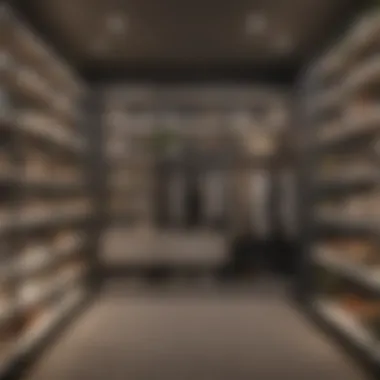

Design Principles for Small Closets
When it comes to optimizing small spaces, understanding the design principles for custom closets plays a pivotal role. It’s about finding that fine line between creating a functional area and retaining an aesthetic appeal. The right design can transform even the most cramped quarters into something that feels both spacious and organized. Essentially, this is not just about stuffing items into any available nook and cranny; it’s about taking a smart approach to storage that aligns with your lifestyle and needs.
Space-Saving Techniques
Utilizing space-saving techniques is vital in small closet designs. One such technique is the use of vertical storage. This can be achieved through tall shelving units or wall-mounted solutions that draw the eye upward, creating an illusion of height. By taking advantage of the vertical space, homeowners can free up the floor area for other uses.
Here are a few effective space-saving tips to consider:
- Floating Shelves: These not only save space but also offer a modern look. They can be used to showcase items like shoes, bags, or even decorative boxes that house smaller items.
- Baskets and Bins: Using these in your closet keeps small items organized and out of sight, maximizing what can fit into individual shelves.
- Multi-Functional Furniture: Think beyond just the closet. For example, an ottoman that doubles as a storage unit can be used for extra seating or a focal point in a room, while also providing stash space.
Balancing Functionality and Aesthetics
Finding that balance between functionality and aesthetic appeal is crucial. A closet shouldn’t be a utility room void of personality; it can and should reflect your style while serving its purpose. For instance, using stylish hangers or choosing colorful bins can add character without sacrificing practicality.
Here are some elements to consider:
- Color Coordination: Select a color palette that resonates with the overall theme of the room. Soft hues can make a space feel open and airy, while bold colors can instill a sense of energy.
- Lighting Elements: Thoughtful illumination can spotlight key features and enhance the overall vibe. If your closet has no natural light, utilizing LED strip lights under shelves adds both warmth and visibility.
- Accessorize Smartly: The right accessories can transform a closet into a chic space. Think elegant boxes for accessories or a stylish shoe rack that doesn't infringe on space but enhances design.
Consideration of Flow and Accessibility
Considering the flow and accessibility of a small closet is not just a design choice; it is a functional necessity. Everything should be within easy reach, allowing one to quickly spot and grab items without the need to sift through clutter.
Some key principles include:
- Zoning Your Closet: Create specific zones for shoes, clothing, accessories, etc. By segmenting these areas, it becomes intuitive to find what you need.
- Pull-Out Systems: Incorporating pull-out racks or drawers can make a significant difference. A good pull-out system brings your items to you, instead of making you dig through stacks or shelves.
- Clear Organization: Labeling containers or sections can help maintain order and speed up the process of finding what you're looking for.
"A well-organized small closet not only maximizes space but also elevates everyday routines into enjoyable experiences."
By integrating these design principles into customized closets, homeowners can effectively transform their limited space into useful and stylish areas that cater to their daily needs. Prioritizing smart designs ensures that while every inch serves a purpose, the overall look doesn’t fall by the wayside in the quest for efficiency.
Material Selection for Custom Closets
The selection of materials for custom closets holds significant weight in the overall effectiveness and longevity of the installation. It influences not just the aesthetics but also the durability, maintenance, and functionality of the closets. Homeowners must carefully weigh their options, considering the specific demands of their space and how different materials will support their storage needs while aligning with their personal style. As an integral part of the design process, the right materials can transform a small space into a well-organized haven.
Durable Materials for Longevity
When designing a custom closet, durability should be at the forefront of your considerations. Using high-quality materials helps ensure that your investment stands the test of time, particularly in areas facing wear and tear. Think about products like plywood, which offers a sound balance between sturdiness and weight. Laminate can also be exceptionally resilient, providing an attractive finish that is resistant to scratches and stains, making it ideal for closets where items are regularly retrieved and stored.
- Plywood: Known for its strength and versatility, plywood can support heavy loads and resist warping.
- Solid Wood: Adds a classic touch but may require more maintenance to prevent deterioration.
- MDF (Medium Density Fiberboard): A cost-effective option that’s less prone to splitting compared to solid wood.
By investing in durable materials, you safeguard your sanctuary against the rigors of daily life.
Eco-Friendly Options
Given the rising environmental consciousness, incorporating eco-friendly materials into custom closet designs can be both a responsible and stylish choice. Many homeowners lean towards sustainable sources, ensuring their choices minimize their carbon footprint. Options like bamboo, which grows rapidly and requires minimal resources for cultivation, provide an excellent alternative to traditional woods. Reclaimed wood also lends character and authenticity to a space while promoting sustainability.
- Bamboo: Strong, light, and sustainable; its rapid growth makes it an eco-friendly option.
- Reclaimed Wood: Offers a unique rustic aesthetic while reducing waste.
- Low-VOC Finishes: Volatile organic compounds can impact indoor air quality, so look for products labeled low-VOC for safety.
Using eco-friendly options not only enhances the aesthetic appeal but also aligns your home with sustainable practices, showing a commitment to the environment.
Finishes and Textures That Enhance Space
The final touches in any closet design, such as finishes and textures, can greatly influence how a space feels and functions. Lighter finishes can create an illusion of depth, ideal for very compact areas; conversely, darker textures can inject warmth and richness into a more expansive wardrobe.
Fabrics also play a role; consider soft-close drawers to maintain a quiet atmosphere and textured handles that provide a visual focal point. Here are some options to consider:
- Glossy Finishes: Reflect light, making small spaces appear larger and more open.
- Textured Panels: Add depth and interest, breaking up monotony.
- Natural Finishes: Keep a close connection to nature, offering soothing aesthetics and feelings.
Applying the right finishes and textures not only beautifies but maximizes your small area, reaping both functionality and elegance.
"Selecting the right materials for a custom closet is a journey. Each choice reflects not just your taste but the life you want to create in your space."
Configuring the Layout
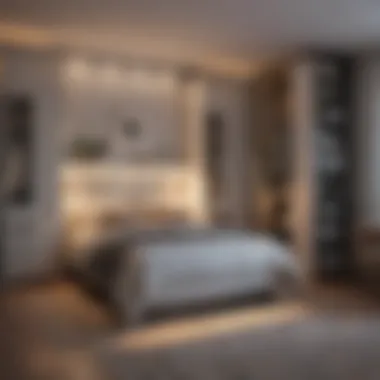
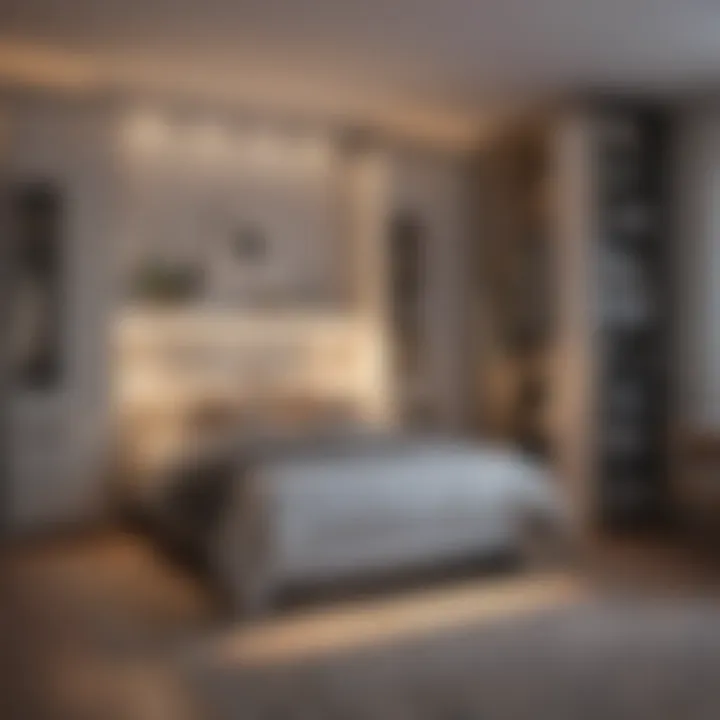
When it comes to custom closets, the layout is everything. A well-thought-out configuration directly impacts the usability and aesthetics of the space. Whether you’re dealing with a cramped apartment or a small bedroom, the way you organize your closet can make all the difference. A smart layout maximizes every inch of your available space while providing easy access to your belongings. It’s essential to focus on specific elements that can enhance functionality and convenience, ensuring that your closet doesn't just store items but does so efficiently and beautifully.
Vertical Storage Solutions
Utilizing vertical storage is like taking advantage of the altitude in a small room; it’s all about using the height of your closet. Many homeowners overlook the potential of vertical space, but it can dramatically increase storage efficiency. For instance, installing shelves that reach up to the ceiling allows for seasonal clothing or items not used often to be stored up high, freeing up lower areas for daily essentials.
- Benefits of Vertical Solutions:
- Increased Capacity: You can fit more in less space.
- Visibility: Placing frequently used items at eye level reduces the need to rummage around, making your morning routine smoother.
- Design Aesthetic: Tall structures can give the illusion of height and add elegance to any room.
When designing these vertical solutions, consider adjustable shelving. This allows you to reconfigure your space over time as your storage needs change, giving you the flexibility to adapt without a complete overhaul.
Incorporating Adjustable Shelves and Rods
Adjustable shelves and rods are a game-changer in closet design. They offer robust functionality, allowing you to personalize the layout based on what you own. Instead of committing to a fixed system that may not suit your needs, adjustable options give you the freedom to create an interior that feels uniquely yours.
In a cramped space, every inch counts.
- Adjustable Shelves:
- Adjustable Rods:
- Users can move shelves up or down based on the size of the items being stored, from shoes to handbags to seasonal gear.
- Enable varying clothing lengths to hang appropriately, utilizing space without crowding.
Imagine a closet where the shorter rods accommodate your shirts, while a higher rod is ideal for longer dresses. This customization not only enhances functionality but also prevents items from becoming wrinkled or damaged, extending the life of your wardrobe.
"Embracing verticality and adjustability is akin to fitting a square peg in a round hole; it’s not just a fit, it’s a smart solution for maximizing storage."
Maximizing Functional Areas
In the realm of small-space living, the concept of maximizing functional areas comes into play as a game changer. The idea behind this section is to recognize that every inch counts, and efficiently utilizing the available space can drastically enhance functionality without overwhelming aesthetics. Custom closets serve as the backbone for creating a well-organized, visually appealing environment that caters to the needs of the homeowner.
By strategically analyzing the layout of your living space, you can identify zones that often go unnoticed or serve minimal purposes. This often involves a good mix of creativity and practicality, allowing you to carve out niches that offer additional storage solutions. It's not just about where things go, but also how those arrangements contribute to an overall sense of order and tranquility.
Utilizing Corner Spaces Effectively
Corner spaces can be a tricky situation for many homeowners. Often seen as wasted areas, they can actually hold untapped potential. Custom closet designs can ingeniously transform these neglected corners into functional storage havens. This can involve
- Corner shelves that allow for efficient use of three-dimensional space. You can place shoes, bags, or even books to make good use of height.
- Lazy Susans or rotating organizers that grant easy access without diving into a jumble. By adding such components, corners aren't just for dust bunnies anymore, they become part of your organization plan.
- Built-in benches in corner areas which not only provide a sitting space but also come with storage underneath. This dual-purpose usage enhances the overall utility of a small room.
Incorporating these solutions not only optimizes the area but also aesthetically complements the surrounding space, making it feel airy and organized.
Incorporating Drawers and Built-Ins
Another essential aspect of maximizing functional areas is the clever incorporation of drawers and built-ins within custom closets. Unlike typical shelving that simply holds items, drawers can provide intentional storage options that keep things out of sight and organized. This makes it easier to locate items when you're in a hurry.
- Drawers that run the full depth of the closet can utilize the space behind the doors effectively. Consider shallow drawers for accessories or deeper ones for bulkier items like sweaters or pajamas.
- Built-ins that are tailored to fit your closet's size and shape can serve diverse functions. Imagine a built-in jewelry box or a pull-out ironing board tucked away for convenience. This means all elements are customized to your lifestyle.
- Adding dividers within drawers can help keep similar items organized and readily accessible. This is especially beneficial in smaller spaces where visual chaos can lead to frustration.
By integrating drawers and built-ins, you can create a custom closet solution that brings both functionality and style to your small space. Each component plays a role in enhancing usability while ensuring the room remains visually appealing.
In summary, harnessing functional areas in your small spaces is not merely about fitting things into tight spots; it’s about designing these areas in a way that promotes ease of use, accessibility, and a clear sense of order.
Integrating Lighting Solutions
In the realm of custom closets, lighting often gets overlooked. However, its significance should not be underestimated. A well-thought-out lighting design does more than just illuminate the space; it transforms how you interact with your closet. When functionality is paramount, having the right lighting can drastically enhance usability, especially in small areas where shadows can easily hide items.
Good lighting not only helps you find what you're looking for but also plays a role in creating a welcoming atmosphere. By highlighting features and providing clarity inside your closet, you make the experience of searching for clothes or accessories less of a chore and more enjoyable. Let's delve deeper into various types of lighting suitable for closets and how you can enhance visibility and ambiance effectively.
Types of Lighting Suitable for Closets
When steering through closet lighting options, one has to consider several factors, including space, design, and, of course, functionality. Here’s a breakdown of some effective choices:
- LED Strip Lights: Slim and versatile, these lights can be affixed along shelves or inside cabinet doors, offering brilliant illumination without taking up much space.
- Puck Lights: Small and often recessed, puck lights can be installed virtually anywhere. They work well in shelving areas, providing targeted lighting on specific items.
- Track Lighting: This type can be adjusted and directed to highlight certain areas of your closet, allowing you to customize the focus based on your needs.
- Motion Sensor Lights: Ideal for closets that are frequently accessed, these lights turn on automatically as you open the door, ensuring you never have to fumble for a switch.
Each option serves a purpose and can complement your closet design while optimizing functionality.
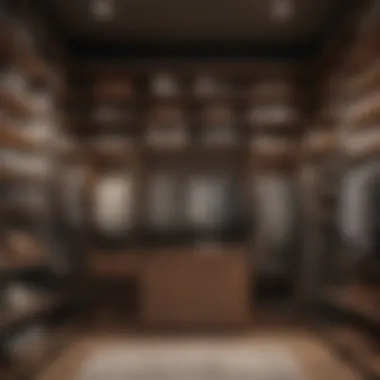

Enhancing Visibility and Ambiance
The interplay of visibility and ambiance in a closet should not be lost on anyone looking to maximize small spaces. With the right lighting setup, you can achieve a harmonious blend of practicality and aesthetics. Consider the following:
- Layered Lighting: Utilizing a combination of ambient, task, and accent lighting allows for flexibility. Ambient light provides overall illumination, task light focuses on specific activities (like choosing an outfit), and accent lights can showcase particular features, such as decorative items or clothing.
- Warm vs. Cool Light: Choosing the right color temperature plays a crucial role in how the closet feels. Warm light tends to create a cozy, inviting environment, while cool light can make the space feel fresher and more expansive.
- Mirrors and Reflective Surfaces: Integrating mirrors enhances brightness by reflecting light within the closet. It creates an illusion of a larger space and improves ambient lighting.
"In a small closet, lighting is where you strike the balance between finding your favorite shirt and making the space enjoyable to be in."
Ultimately, integrating thoughtful lighting solutions is about maximizing both practicality and style. The right approach will have you enjoying your small space to the fullest, making closet exploration efficient and pleasant.
Budget Considerations
When it comes to creating custom closets, budget considerations play a pivotal role. Balancing costs with the need for functional and aesthetic solutions can be tricky but essential. Each decision made can significantly affect the overall effectiveness of the closet design, making it crucial for homeowners to fully grasp what’s at stake before diving in.
Estimating Costs of Custom Designs
The first step in navigating the financial aspect is estimating costs associated with custom designs. Various factors determine the price point of your project:
- Size of the Closet: Larger closets usually means higher costs since more materials and labor will be needed.
- Material Choices: Opting for higher-end materials like hardwood will undoubtedly raise the budget, while alternatives like laminate might give a similar look without breaking the bank.
- Design Complexity: A straightforward design is typically less costly than intricate ones featuring specialized solutions.
Having a clear understanding of these elements not only prepares you for what’s to come but also allows for better planning. Engaging with a designer may help you estimate costs better, as they can provide a clearer picture based on your preferences and available space.
Identifying Cost-Effective Solutions
Once you have a ballpark figure for your custom closet, the next step is to identify cost-effective solutions that could help you stay within budget while achieving your goals.
- DIY Elements: Incorporating do-it-yourself aspects can largely reduce labor costs. Simple tasks like painting, assembling pre-made units, or organizing can go a long way.
- Second-Hand Finds: Don’t underestimate the potential of pre-loved furniture or materials. These can often be refurbished or repurposed, giving you a uniquely styled closet without a hefty price tag.
- Sales and Discounts: Timing your purchase around sales can lead to major savings. Keep an eye on local stores and online retailers for discount events.
"A penny saved is a penny earned." Wise budgeting not only enhances your closet but also allows for other improvements around the home.
From practical materials to thoughtful design choices, each aspect needs careful deliberation. Understanding financial parameters can offer not just savings, but also drive creativity in your closet's layout and functionality. Taking the time to outline a budget will ultimately lead to realizable expectations and satisfaction long after your custom closet is complete.
Maintenance and Upkeep
When it comes to custom closets, a wise homeowner knows that maintenance and upkeep are not just an afterthought but a vital part of keeping the closet functional and appealing. After all, even the most beautifully designed closet can quickly fall into disarray without the right care. In the whirlwind of daily life, it's easy to neglect the little things, but a bit of attention can extend the lifespan of your investment and boost its functionality.
A well-maintained closet does more than just look good; it enhances your day-to-day experience, making it easier to find what you need without rummaging through unnecessary items. Additionally, maintaining order can actually save time, reducing those moments of frustration when searching for the elusive blue scarf or your favorite pair of shoes.
Routine Cleaning Tasks
To maintain a clean and orderly custom closet, routine cleaning tasks are essential. Here’s where regularity becomes your friend. Rather than waiting for chaos to reign supreme, try to adopt the habit of tidying up every so often. For example:
- Weekly Spot Checks: Take a few minutes each week to assess the general state of your closet. Look for misplaced items or any signs of dust gathering on shelves.
- Monthly Deep Clean: Dedicate time each month for a more thorough cleaning session. This is when you'll want to pull everything out, dust the shelves, and tidy up the flooring. Consider wiping down surfaces with a gentle cleaner to prevent any residue build-up.
- Declutter Regularly: Every few months, take stock of your belongings in the closet. Assess whether every item serves a purpose or brings you joy—and if not, it might be time to pass it along.
Consistency in these tasks keeps the closet in top-notch shape and makes the upkeep feel less daunting.
Long-Term Care for Materials
Feeling responsible for the materials of your custom closet? Good on you! Long-term care of the components is crucial for maintaining their durability and appearance. Different materials require different approaches, so here’s a breakdown:
- Wood: If your closet features wood elements, regular dusting with a soft cloth is your best friend. A gentle wood polish can help maintain the sheen and protect against scratches. Avoid direct sunlight to prevent fading over time.
- Metal: For metal components, a quick wipe with a damp cloth should do the trick. If your closet has a painted finish, be cautious with abrasive cleaners as they can damage the surface.
- Fabric: For fabric bins or drawers, check their care tags regularly. Some may be machine washable, while others may need a more delicate approach, such as spot cleaning or the use of lint rollers for pet hair.
By paying attention to these aspects of maintenance, you can keep your custom closet not just a storage area, but also a long-lasting part of your home's aesthetic.
"An ounce of prevention is worth a pound of cure"—this adage rings especially true when it comes to the upkeep of custom closets. Regular maintenance can stave off nagging problems and ensure your investment doesn't lose its charm.
Ultimately, integrating consistent maintenance and being mindful of material care can transform how you use and enjoy your custom closet. With a proactive approach, navigating your small spaces can become not just practical but also satisfying.
Showcasing Style Through Design
When it comes to custom closets, showcasing style through design is not just about looks. It’s about marrying function with personal expression. A well-designed closet can enhance the overall aesthetic of a space while also serving its primary purpose—storage. In small areas, this balance becomes even more critical. Finding ways to integrate style without it coming at the expense of functionality can be the difference between a cluttered room and a harmonious one.
Incorporating Personal Aesthetics
Infusing personal aesthetics into closet design allows homeowners to turn an often-overlooked area into a standout feature of their home. Here’s how to weave individual style into your custom closet:
- Color Selection: Choosing colors that resonate with your personal style helps create a space that feels like an extension of you. Whether it’s a soft pastel or a bold contrast, colors can dramatically affect your mood when entering the closet.
- Material Choices: Opting for unique materials, such as reclaimed wood or metal accents, can add character. These choices not only influence the appearance but also affect durability—a crucial factor in small space living.
- Hardware and Fixtures: Sometimes, it’s the little things that count. Handles, knobs, and hooks can be conversation starters when carefully selected. Think of them as jewelry for your closet that complements your overall design theme.
- Personal Touches: Consider adding elements that reflect your personality. This could include framed pictures, decorative boxes, or even curated bookshelves. These details can make the closet feel less like a utilitarian space and more like a tailored area that showcases who you are.
- Lighting Effects: Lighting can set the mood in any room. Opt for warm hues or well-placed spotlights to highlight favorite items. A dramatic light fixture can serve as a stunning focal point, drawing attention and admiration.
Showcasing style through design turns a mere storage area into a reflection of one’s personality and lifestyle. It’s about making smart choices that transform an everyday task into a delightful experience.
"A closet isn’t just for storage; it’s a canvas for personal expression."
In a world where space is often at a premium, turning that space into something that isn’t just functional but also breathtakingly beautiful can change the way you perceive your living environment. Making choices that speak to your individual taste brings style and utility into perfect harmony, showing that even in small spaces, you don’t need to compromise aesthetics for practicality.



